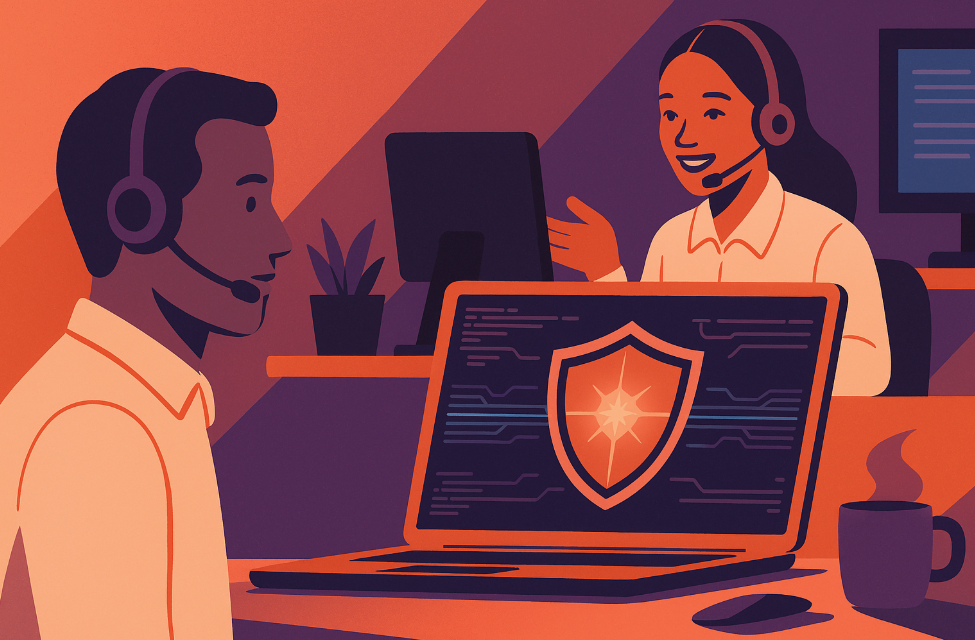Infrastructure Security Best Practices
Cyber threats grow more sophisticated each day, ranging from ransomware and phishing attacks to state-sponsored hacking and insider threats. With IT infrastructure spanning servers, networks, storage, and cloud services, any weak link in the chain can expose your entire organisation to breaches or downtime. Hence, infrastructure security is a top priority - embedding protective measures at every level.
In this article, we’ll explore infrastructure security best practices - why they’re essential, common pitfalls, and practical steps to fortify your environment. We’ll also reference some of our earlier posts - like Hybrid IT Infrastructure and Datacentre Management - to show how security considerations fit into a broader IT strategy. Whether you’re a small team on the Central Coast (NSW) or a global enterprise, prioritising security across servers, networks, and cloud resources is crucial for safeguarding data, maintaining trust, and ensuring long-term resilience.
Why Infrastructure Security Matters
Data Protection
Sensitive information (customer records, financial data, intellectual property) can be stolen or altered if your infrastructure lacks robust defences.
Business Continuity
Cyberattacks like ransomware can halt operations, causing lost revenue and reputational damage. Strong security measures limit the blast radius.
Regulatory Compliance
Many industries mandate data protection standards (e.g., PCI-DSS, HIPAA, GDPR). Failing to comply can lead to hefty fines or legal repercussions.
Preserving Customer Trust
Breaches erode consumer confidence. Demonstrating robust infrastructure security fosters trust, especially for e-commerce or SaaS businesses.
Evolving Threat Landscape
Attackers constantly refine tactics. Infrastructure security best practices ensure you stay ahead of known exploits and adapt to emerging threats.
Core Principles of Infrastructure Security
Defence in Depth
What: Layer multiple security controls - firewalls, intrusion detection, encryption, segmentation - so if one fails, others still protect you.
Why: Attackers often exploit the path of least resistance. Multiple barriers slow them down or detect them early.
Least Privilege
What: Give users, services, or processes the minimal level of access required to perform their tasks - nothing more.
Why: Minimising permissions reduces the damage a compromised account can do, stopping attackers from moving laterally across infrastructure.
Zero Trust
What: Assume every user, device, or network segment is untrusted - authenticate and authorise each request, every time.
Why: Removes implicit trust for “internal” networks, which may contain compromised hosts or rogue insiders.
Segmentation and Isolation
What: Partition infrastructure so critical systems aren’t on the same network as general endpoints or public-facing services.
Why: Limits the blast radius if an attacker compromises one segment. They can’t easily pivot to high-value targets or data.
Continuous Monitoring
What: Keep an eye on system logs, network traffic, and user behaviour in real time.
Why: Early detection of anomalies - like unusual login attempts, surging CPU usage, or large data transfers - lets you respond swiftly.
Best Practices for Securing Infrastructure
Network Security
Firewalls: Enforce strict inbound/outbound rules, blocking all but necessary ports or protocols. Consider next-generation firewalls (NGFW) with deep packet inspection.
VPN and Encrypted Tunnels: Secure remote access and site-to-site connections with robust encryption (e.g., IPsec or TLS-based).
IDS/IPS: Intrusion Detection/Prevention Systems watch for malicious traffic patterns or known exploits, alerting or blocking them in real time.
Server and OS Hardening
Regular Patching: Timely apply OS and application updates. Unpatched servers are a top target for hackers exploiting known vulnerabilities.
Least-Privilege Configuration: Disable unused services or ports, run applications with minimal privileges, and remove default accounts or credentials.
File Integrity Monitoring: Detect unauthorised changes to critical files - potential signs of tampering or malware.
Access Management
Multi-Factor Authentication (MFA): Enforce MFA for admin accounts, VPN logins, and critical systems to prevent credential theft from granting full access.
Role-Based Access Control (RBAC): Group privileges by job roles, ensuring employees or contractors only see what they need.
Strong Password Policies: Length and complexity requirements, plus rotation for critical accounts.
Data Encryption
At Rest: Encrypt disks or databases storing sensitive info (e.g., AES-256 for volumes, TDE for databases).
In Transit: Use SSL/TLS for all traffic, from internal APIs to user-facing websites, and secure protocols like SFTP over plain FTP.
Monitoring and Logging
Centralised Logs: Aggregate system, network, and application logs in a SIEM (Security Information and Event Management) or log analytics platform.
Real-Time Alerts: Define thresholds (multiple failed logins, abnormal traffic spikes) that trigger immediate notifications.
Retention: Keep logs long enough for forensics or compliance - some regulations require up to a year or more.
Physical Security
Datacentre Controls: Locked racks, surveillance cameras, biometric access, anti-tailgating measures.
Secure Disposal: Shred or wipe old hard drives, network gear, or backup tapes thoroughly.
Visitor Management: Restricted entry, visitor logs, escorts for third-party technicians.
Common Infrastructure Security Challenges
Shadow IT
Problem: Employees or departments deploy their own servers or cloud services without central oversight.
Solution: Foster a culture of collaboration with IT, provide easy-to-request official resources, and use network scans or cloud discovery tools to spot unauthorised deployments.
Human Error
Problem: Misconfigured firewalls, reused passwords, forgetting to patch a server.
Solution: Training (phishing drills, secure coding), routine audits, and automation (Infrastructure as Code to standardise configurations).
Zero-Day Vulnerabilities
Problem: Unknown software flaws can be exploited before patches exist.
Solution: A layered defence approach (IDS, WAF, behaviour analytics) plus timely patch processes once a fix emerges.
Cloud Misconfigurations
Problem: Publicly exposing S3 buckets, leaving default credentials in cloud VMs.
Solution: Strict IAM, regular cloud security posture assessments, scanning tools that check for open ports or misconfigured storage.
Insider Threats
Problem: Disgruntled employees or careless staff can misuse privileges to leak data.
Solution: RBAC, stringent audit logs, real-time alerts on large data exports or unusual account usage.
How a Managed IT Services Provider Can Help
A Managed IT Services partner can bolster infrastructure security by:
Assessing Security Posture: Conducting penetration tests, vulnerability scans, or compliance audits to spot gaps.
Implementing Best Practices: From configuring firewalls and WAFs (Web Application Firewalls) to setting up SIEM solutions for advanced threat detection.
24/7 Monitoring: Round-the-clock vigilance for security anomalies, plus immediate incident response capabilities.
Patch and Configuration Management: Automated tools that keep servers, network devices, and applications up to date across on-prem and cloud.
Incident Response and Forensics: If a breach does occur, MSPs help contain threats, investigate root causes, and recommend improvements.
For guidance on selecting the right security-focused MSP, see How to Choose a Managed IT Provider.
Measuring Security Effectiveness
As with other IT efforts, refer to Evaluating Managed IT Performance for overarching KPIs. For security specifically, consider:
Number and Severity of Incidents
Are threats detected early? Are major breaches declining over time?
Patch Compliance Rate
Percentage of systems fully patched within required timelines. A higher rate implies good patch management discipline.
Mean Time to Detect/Respond
How quickly do you discover security events and neutralise them once alerted?
Audit Findings
Reduction in compliance violations or vulnerabilities identified by third-party audits or pen tests.
User and Customer Confidence
Surveys or feedback on trust levels, particularly for customer-facing services.
Why Partner with Zelrose IT?
At Zelrose IT, we treat infrastructure security as a holistic endeavour - protecting servers, networks, storage, and cloud endpoints through a layered, proactive approach. Our capabilities include:
Security Assessments: Identifying vulnerabilities or misconfigurations, then outlining action plans.
Zero-Trust Implementations: Applying network segmentation, strong identity management, and continuous verification.
Patch and Configuration Management: Automated updates across OSes, firmware, and applications to close known exploits.
24/7 Threat Monitoring: Advanced SIEM tools that correlate logs and events, detecting suspicious activities in real time.
Incident Response: Swift containment if an attack occurs - minimising damage, aiding forensic analysis, and strengthening defences post-incident.
Ready to boost your organisation’s security posture? Reach out for tailored solutions that blend best practices, modern tools, and a security-first mindset.
Infrastructure security isn’t just about adding a firewall or running an antivirus. It’s a comprehensive strategy - encompassing network segmentation, server hardening, access controls, encryption, monitoring, and more. As threats evolve and organisations adopt hybrid or cloud models, security measures must adapt equally fast, embedding layered defences and zero trust principles into every layer of infrastructure.
By following best practices like defence in depth, least privilege access, regular patching, and continuous monitoring, you create an environment resilient to breaches, downtime, and compliance pitfalls. And if you lack the expertise or bandwidth in-house, a Managed IT Services provider with proven security experience can cover everything from design to daily monitoring.
Looking to fortify your infrastructure against modern cyber threats?
Contact Zelrose IT for comprehensive security solutions - tailored to your IT environment, risk profile, and business goals. Together, we’ll ensure your infrastructure remains robust, compliant, and ready to take on tomorrow’s challenges.




